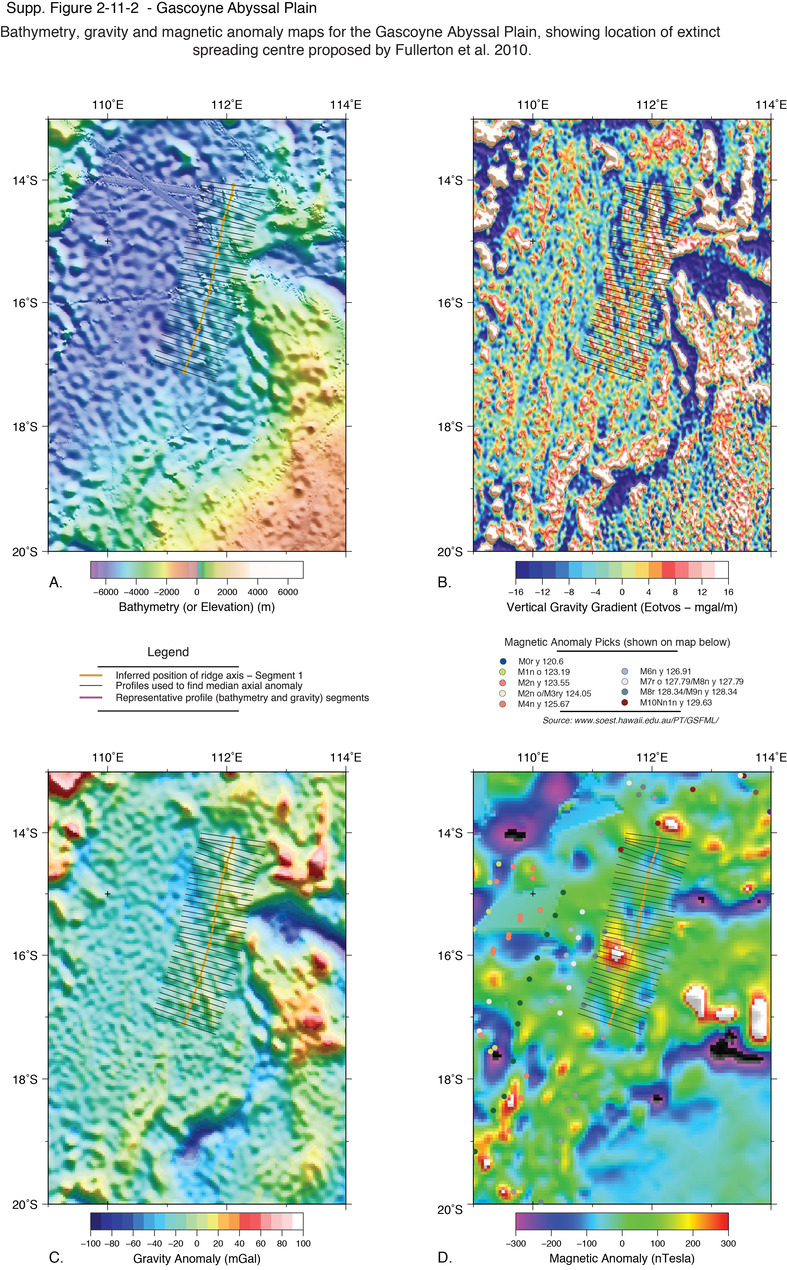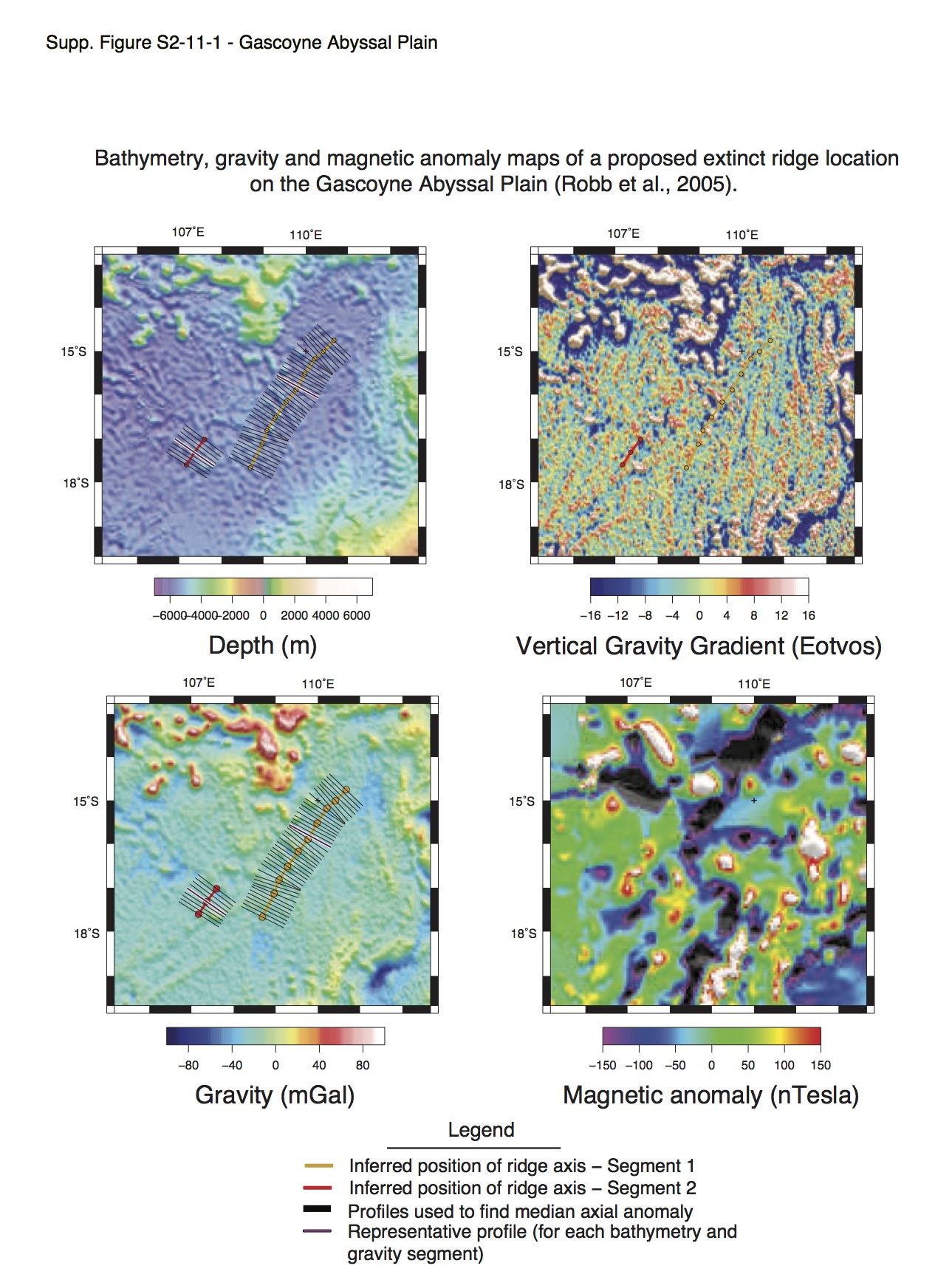| Ocean: | Indian |
| Spreading center type: | Proposed large-scale extinct mid ocean ridge |
| Time of cessation: | Ca. 121 Ma, chron M0 (Robb et al., 2005) or ca. 125 Ma, chron M4 (Fullerton et al., 1989) |
An early studies of the Gascoyne Abyssal Plain interpreted a set of approximately N-S trending M-series magnetic anomalies as of Cretaceous age and placed an extinct ridge axis between 13° S and 17° S (Fullerton et al.,1989). This placement does not correspond to a bathymetric feature that is suggestive of an extinct axis and the recent seismic reflection investigation of Rey et al. (2008) did not identify any prospective candidates, although several volcanic ‘protrusions’ are noted. Alternative interpretations of the regional magnetic anomalies on the Gascoyne Abyssal Plain have inferred a one-sided sequence of magnetic anomalies to the West Australian margin and do not require an extinct ridge, assuming that the conjugate crust has been subducted to the north (Mihut and Müller, 1998; Heine and Müller, 2005; Gibbons et al., 2012).
Robb et al. (2005) re-interpreted magnetic anomalies in the Gascoyne and Cuvier Abyssal Plains and defined an extinct ridge in the Middle Gascoyne Abyssal Plain, with symmetric anomalies M5 to M1 reported around the inferred extinct ridge, although there is nop bathymetric or gravity feature associated with this placement that has extinct ridge-like form.
Robb et al. (2005) proposed that the gradual progression of spreading axes to the west and north was likely a result of an inherited large-offset between adjacent spreading segments and that the ridge axis may have migrating to reduce this offset. Robb et al. (2005) also acknowledge the possibility of influence of a thermal anomaly, such as a hotspot that may have led to a spreading cetnre migration.
Two studies have proposed that ridge-jumps occurred within the Gascoyne Aybssal Plain seafloor, resulting in extinct ridge axes (Fullerton et al., 1989 and Robb et al, 2005). We have digitized and evaluated the proposed placements but found that neither clearly reflected the morphology of an extinct ridge and that there is insufficient evidence at present to support location of extinct spreading axes in this region.
Fullerton, L.G., Sager, W.W. and Handmuscher, D., 1989, Late Jurassic‐Early Cretaceous evolution of the eastern Indian Ocean adjacent to northwest Australia, Journal of Geophysical Research, v. 94, no. B3, p. 2937–2953.
Gibbons, A.D. et al., 2012, Constraining the Jurassic extent of Greater India: Tectonic evolution of the West Australian margin. Geochemistry, Geophysics, Geosystems, v. 13, no. 5, p.Q05W13.
Heine, C. and Müller, R.D., 2005, Late Jurassic rifting along the Australian North West Shelf: margin geometry and spreading ridge configuration, Australian Journal of Earth Sciences, v. 52, no. 1, p. 27–39.
Mihut, D. and Müller, R.D., 1998, Volcanic margin formation and Mesozoic rift propagators in the Cuvier Abyssal Plain off Western Australia, Journal of Geophysical Research: Solid Earth, v. 103, no. B11, p. 27,135–27,149.
Rey, S.S., Planke, S., Symonds, P.A. and Faleide, J.I., 2008, Seismic volcanostratigraphy of the Gascoyne margin, Western Australia, Journal of Volcanology and Geothermal Research, v. 172, no. 1, p. 112-131.
Robb, M.S., Taylor, B. and Goodliffe, A.M., 2005, Re-examination of the magnetic lineations of the Gascoyne and Cuvier Abyssal Plains, off NW Australia, Geophysical Journal International, v. 163, no. 1, p. 42–55.





